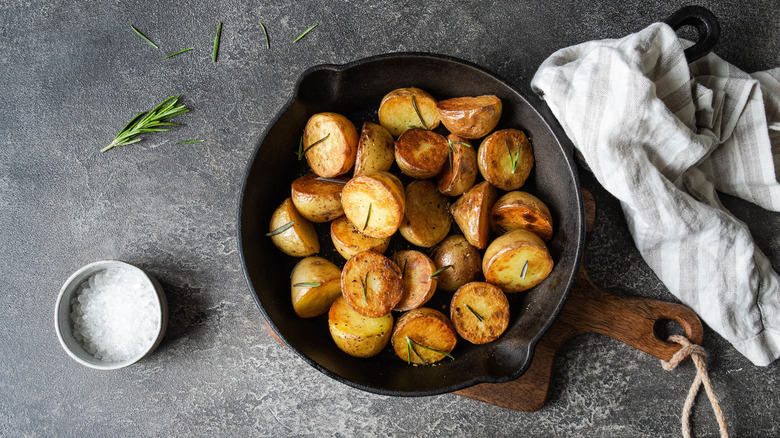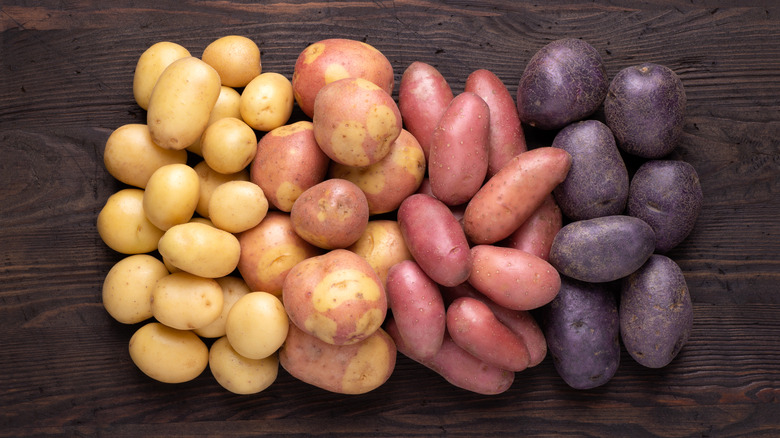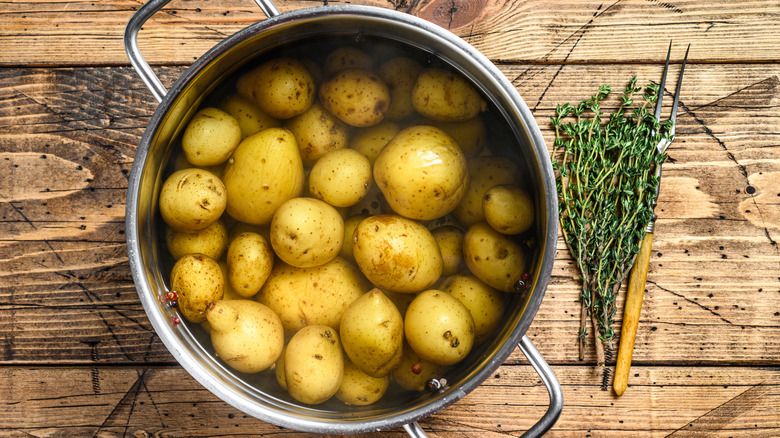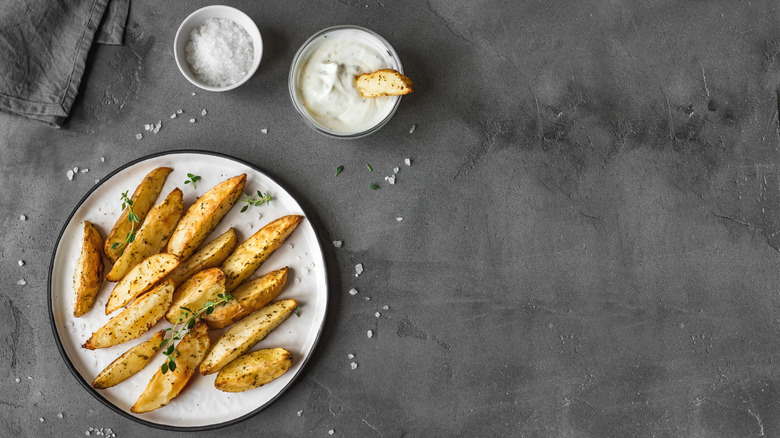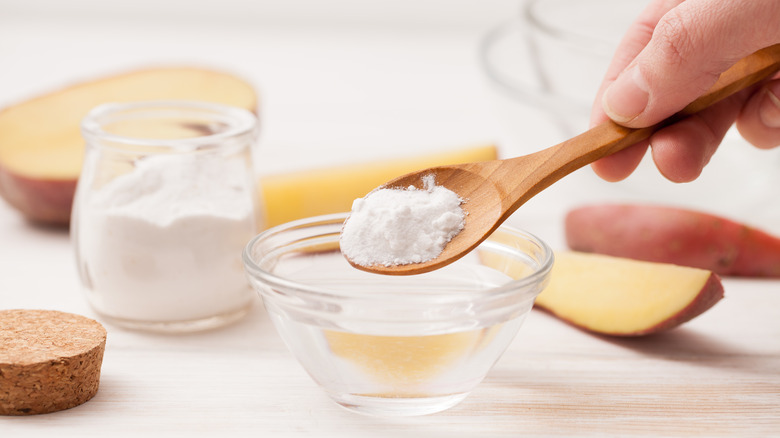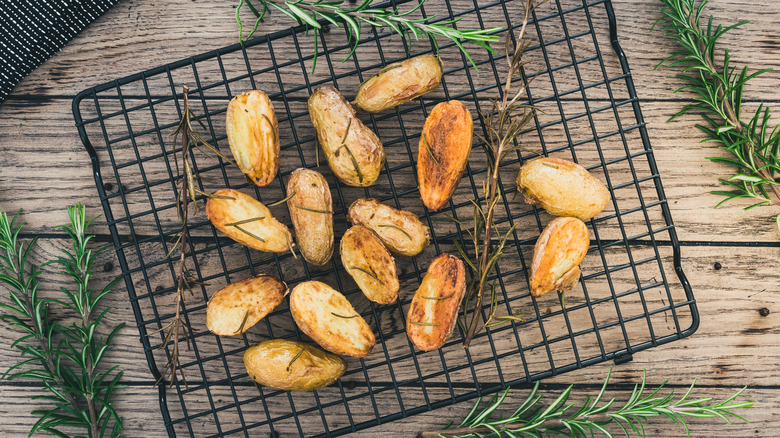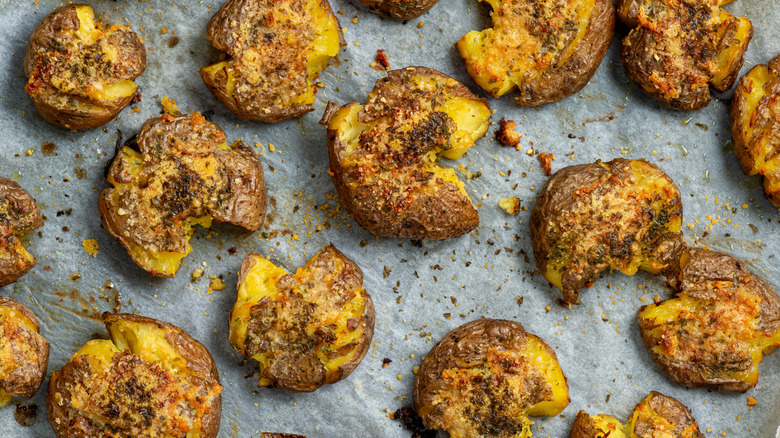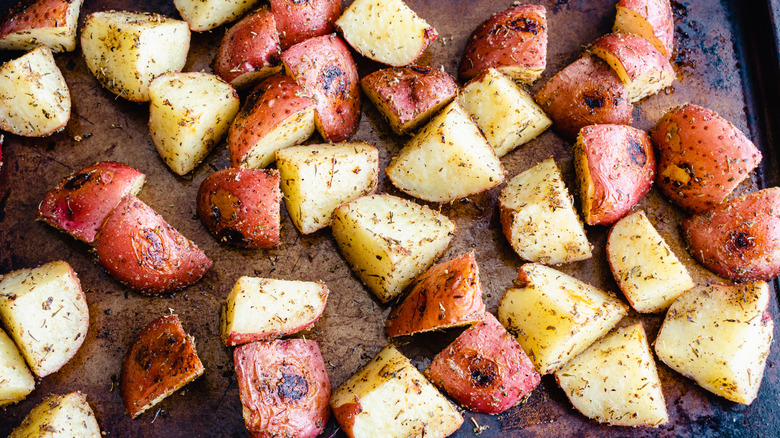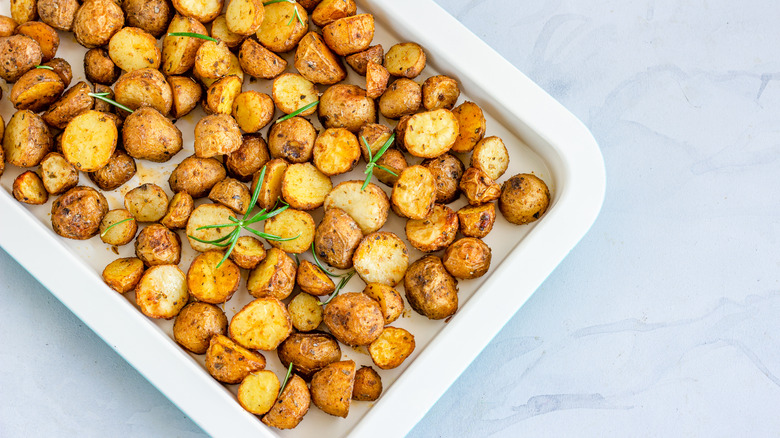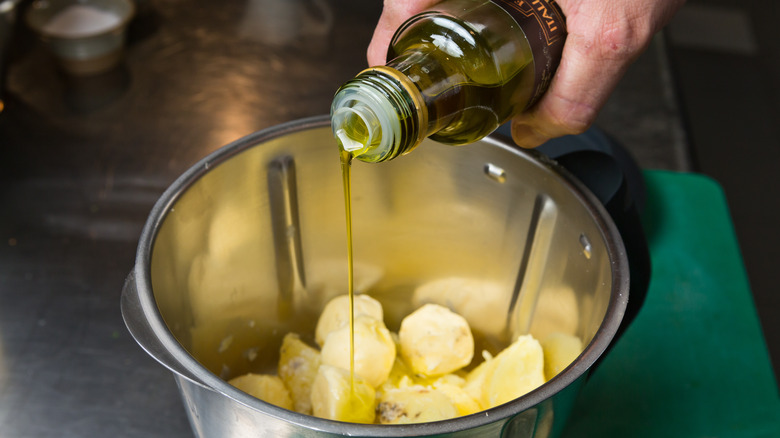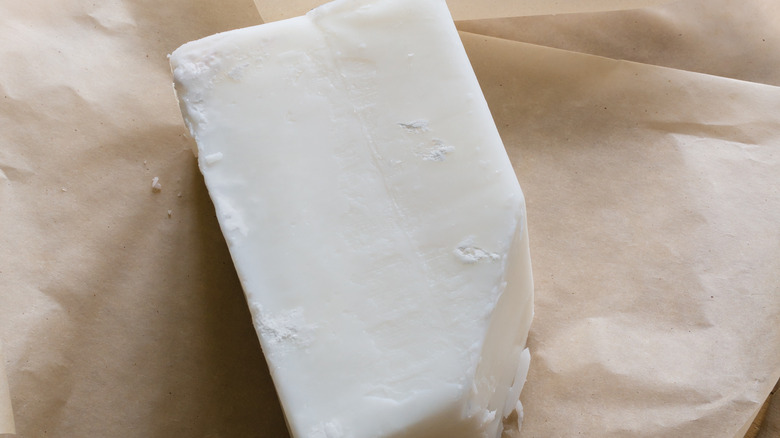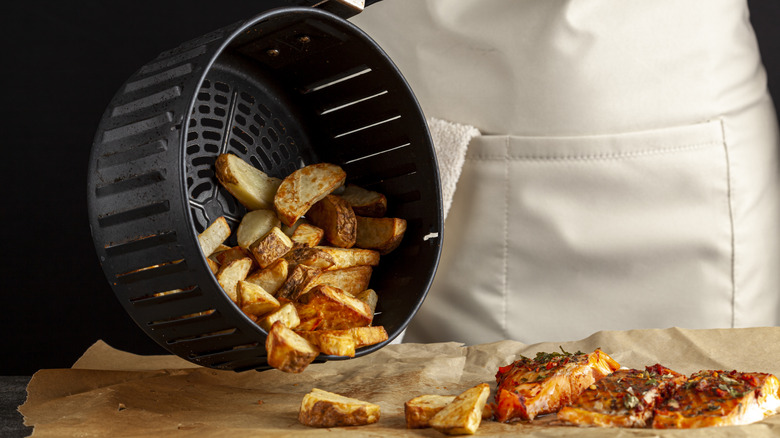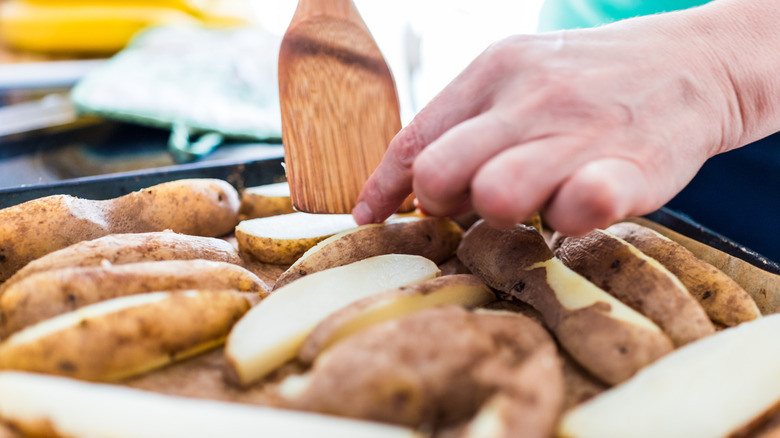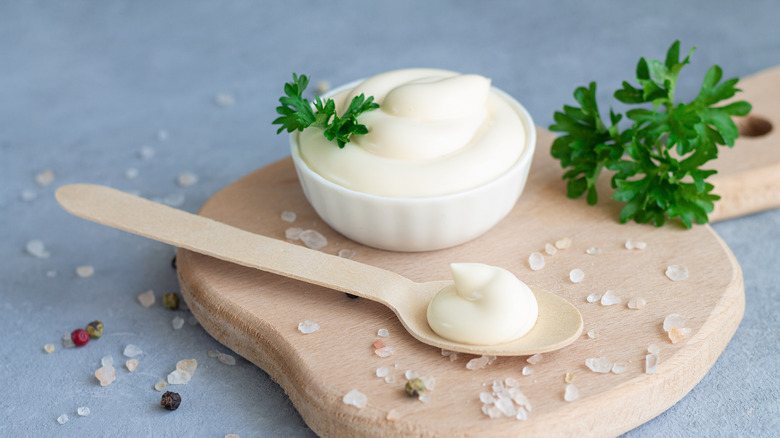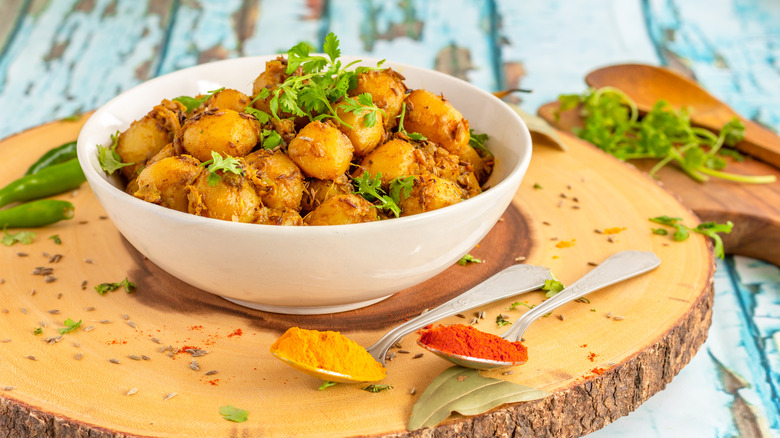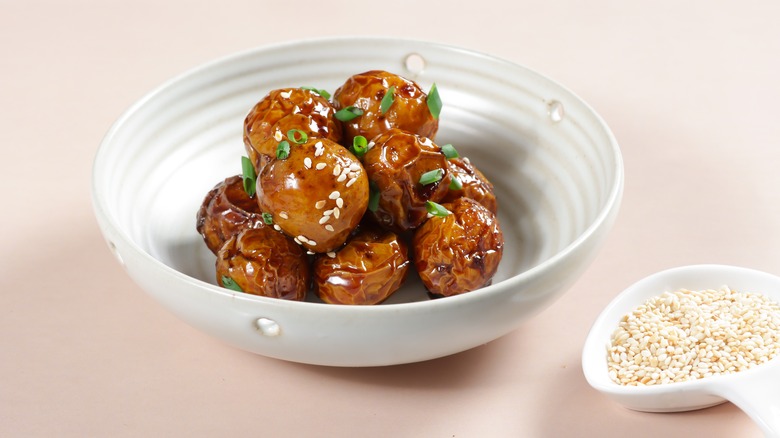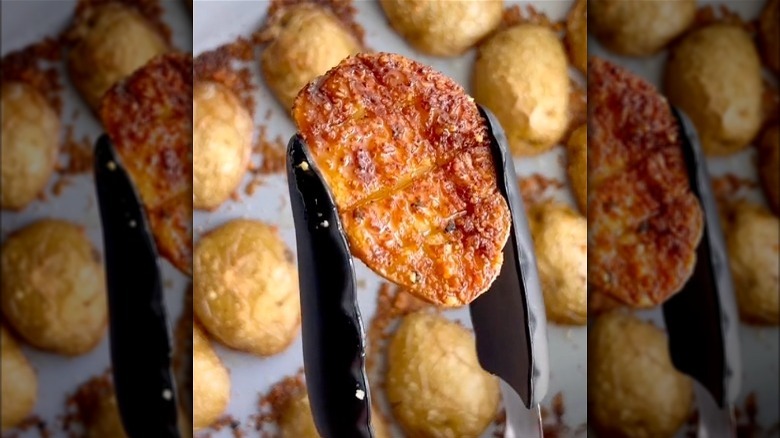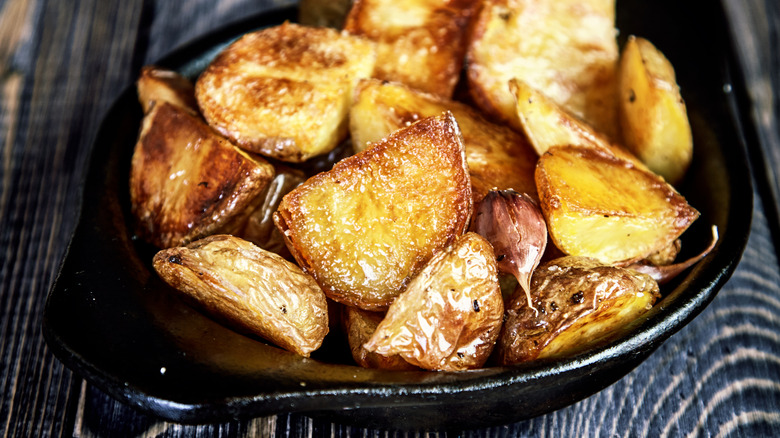17 Potato Roasting Hacks You'll Wish You Knew Sooner
Few things are as satisfying as a pan of perfectly roasted potatoes. When cooked properly, you end up with a spud that's crispy on the outside and buttery on the inside — it's like achieving the best of both worlds between a french fry and a bowl of velvety mashed potatoes. Potatoes prepared in the oven make the ideal side dish for roasted meats, rich fish dishes, or vegetarian dinners, and they're the ultimate snack with a creamy dipping sauce.
Unfortunately, it's all too easy to end up with potatoes that fall short, whether they're undercooked or they steam on the baking sheet instead of roasting properly, resulting in a lackluster bite. If you're looking for absolutely gorgeous potatoes that are crunchy enough to hear as you bite into them, use one (or a few) of these potato roasting hacks. Most of them are so easy and only require a small modification from your current technique.
Use the right potatoes
When it comes to achieving flawless texture and consistency, the type of potato you use matters. Farmers grow over 200 types of potatoes worldwide, so you get to choose from more than a few options. In general, it's best to steer clear of the starchy varieties, like Russet and Kennebec. The soft, fluffy texture of these potatoes makes them ideal for baking and preparing french fries, but not so much for roasting. Starchy potatoes can fall apart easily, and they tend to turn out dry.
The best potatoes for roasting are thin-skinned and waxy, like fingerling, red bliss, or German butterballs. Although they're considered a hybrid potato (falling somewhere between a waxy and starchy potato), Yukon golds also work really well for making roasted potatoes. These potatoes hold their form and stay moist inside while the exterior browns in the hot oven.
Parboil the potatoes first
The easiest way to elevate your roasted potatoes is to start with a simple step: parboiling. Boiling the potatoes in salted water tenderizes the tough tuber, helping it achieve a crunchy, roasted texture with a creamy interior. Roasting the potatoes without parboiling them would be a mistake, as it can lead to burnt potatoes that are still hard inside.
Keep in mind that there's a difference between blanching and parboiling potatoes. Blanching only calls for cooking the potatoes until the water comes to a rolling boil and the potatoes are removed to ice water to stop the cooking process. This step is helpful when freezing potatoes, but it's not enough when roasting potatoes. For a proper parboil, you'll want to cook the potatoes in boiling water for about 10 minutes or until the center is soft when pierced with a fork.
Salt your potatoes the right way
It's advice like this that makes new cooks throw up their hands and want to give up before they even get started. What do you mean there's a right and wrong way to salt potatoes? Before you get too frustrated, we'll start by saying that skipping this step won't completely ruin your potatoes. But taking this advice is a potato roasting hack that will make your potatoes taste fantastic.
Parboiling potatoes in salted water seasons the potato from the inside out, helping them taste their best as they roast in the oven. If you forgot to salt the cooking water, though, we advise waiting until after you roast the potatoes to sprinkle on the salt. Directly salting the potatoes before they go into the oven will draw out moisture from the center of the potato, preventing it from fully crisping up as it cooks.
Add a little baking soda to the mix
Instead of salting your water when parboiling, you may want to consider using baking soda instead. This little bit of food science is one of those things that can take your roast potatoes to the next level because of the way the baking soda interacts with the potato's starches. According to cooking expert J. Kenji Lopez-Alt, adding baking soda creates an alkaline environment that breaks down the potato's surface, drawing out the tuber's natural starches.
The end result is an improved texture, and as a bonus, the potato also looks more appetizing because of its golden-brown appearance. To pull it off, bring a pot of water to a boil before adding a ½ teaspoon of baking soda (per 2 quarts of water) and your cut potatoes. Bring the water back to a boil and cook for 10 minutes before draining and roasting the potatoes.
Let your potatoes dry before roasting them
One of the most important rules about roasting vegetables is to give them plenty of space on the baking sheet. Otherwise, the steam released by the cooking process can prevent caramelization, leaving the vegetables mushy. This advice holds true for potatoes as well, but there's an additional hack that will help the exteriors cook up to perfection.
When it comes to roasting potatoes, it's important to make sure they are also dry before they hit the oven. Actress Emily Blunt shared this hack in her roasted potato recipe that broke the internet when it was shared by none other than Ina Garten (if the Barefoot Contessa herself endorses it, you know it's worth trying). After parboiling the potatoes, Blunt drains the potatoes and leaves them on a wire rack to dry for 15 minutes. This step helps to form a crust on the outside, resulting in superior texture.
Increase the potato's surface area for more crispy bits
Most of us probably chop potatoes into bite-size pieces, throw them into a roasting pan, and hope for the best. That certainly works, but there's a better way and it involves increasing the potato's surface area. There are a few techniques you can use to accomplish this. One is to smash the potatoes with the back of a glass or jar. Flattening the potato turns them into a latke or fritter shape that will help to ensure crispy edges.
Another popular method is a classic British technique that involves shaking parboiled potatoes in a pot or roughing them up with a spoon before roasting. Not only with this create cracks and craggy edges, but it also bruises the potato's starchy network to allow the cooking fat to seep into the increased surface area. As a result, the potatoes brown more effectively in the oven and turn out that much better.
Always preheat the baking pan
Once you start using this potato roasting hack, you'll wonder why no one told you about it sooner. The idea here is to preheat the baking pan before you add the cut potatoes, reducing their overall cooking time while enhancing their level of crunch. It makes sense when you think about it; when was the last time you cooked anything on the grill or on the stovetop without preheating the pan first?
Simply place your baking sheet in the oven while it goes through its preheat cycle. When the oven is preheated, remove the pan (using oven mitts, of course) and add a layer of cooking oil. Be careful when you add the potatoes here as the heat can cause any moisture on their surface to spit and splatter when it hits the hot pan.
Roast potatoes in a high-temperature oven
If you're roasting potatoes in a 350 F oven, you're really missing out. That's not to say that there's anything wrong with baking at 350 degrees. The temperature became something of a golden rule for roasting because of the Maillard reaction (the term used to describe the process of creating that golden crust on food as it cooks). The sugars in meat and vegetables start to brown between 300 and 350 F, so setting your oven at these temperatures ensures that anything from cookies to roast chicken will turn out with a golden brown crust.
Of course, that doesn't mean you shouldn't crank up the oven temperature if you're trying for picturesque roast potatoes. Molly Yeh's two-step approach for perfect roast potatoes includes a quick boil followed by a roast in a 450 F oven for about 30 minutes. Since the potatoes are already soft in the middle, you don't have to worry about them being raw or uncooked by the time the outsides cook, and the high oven temperature works to crisp up the outsides beautifully.
Don't skimp on the oil
This isn't necessarily the healthiest piece of advice, but the greatest roasted potatoes are cooked with plenty of high-quality cooking oil. If you don't use enough, the potatoes can turn out dry and wrinkled. Of course, using too much can cause them to be soggy and limp, so you'll want to use just enough for making the best roasted potatoes.
So how much oil is the right amount when roasting veggies? A good rule of thumb is to use one tablespoon of oil per pound of vegetables. Make sure the oil you choose has a high enough smoke point, too, or it can turn rancid and off-flavored in the oven. Stick to pure olive oil when roasting at 425 F, or look to avocado oil, peanut oil, refined vegetable oil, or ghee for roasting at 450 F.
Maximize flavor with animal fat
It would be a huge mistake to limit yourself to conventional cooking oils. One of our favorite potato roasting hacks is to think outside the box when it comes to how we season the potatoes, and choosing a savory cooking fat is a great way to add flavor with very little effort.
The next time you make this tasty side dish, upgrade your roasted potatoes with beef drippings. You can save the drippings from making your own roast beef or purchase beef tallow at a butcher shop. Heat one tablespoon of beef tallow per pound of potatoes to melt the fat and make it easier to evenly coat the potatoes. You can also look to other tasty meat drippings, like bacon grease, lard (pork fat), schmaltz (chicken fat), or duck fat.
Consider using the air fryer instead of the oven
If you have an air fryer, you should absolutely be air frying your "roast" potatoes — and you might want to consider getting one if you don't have one on hand. These gadgets are basically tabletop convection ovens that use a fan to circulate hot air around the cooking food. They can be used with little to no oil but can still crisp food as effectively as a deep-fryer, making them healthier than the alternative without sacrificing taste or texture.
Air-fried potatoes turn out just as crunchy as a 450 F oven even without all that extra cooking oil. You'll want to cut the potatoes into uniform pieces to ensure they cook evenly and don't forget to shake the air fryer basket from time to time to promote browning on all sides.
Stop bothering them so much
If you're using every other hack on this list but find that you're still not achieving perfect roasted potato results, you might need to stop bothering your roast potatoes so much. It is important to turn potatoes halfway through to promote even cooking on each side, but turning them too much won't allow them to caramelize, so you'll miss out on that ideal roasted potato texture.
To ensure you're not turning the potatoes before they have a chance to sear, place them in the oven and set a timer for half the potato's cooking time. Depending on the roasting temperature and your individual recipe, that's probably anywhere from 15 to 20 minutes. When the timer goes off, give the potatoes a flip, but resist the urge to move them before that clock expires.
Slather your potatoes with mayo before roasting
This is a weird hack, especially for the mayonnaise haters in the room, but it turns out you really should slather potatoes in mayo before you roast them. The idea here is that mayonnaise has a high fat and protein content that protects the potato from burning, creating an impeccable exterior while promoting a soft, pillowy interior. Mayonnaise works well for creating sublime grilled cheese sandwiches, and it's effective as a marinade for meat, so why not try it on potatoes?
To make it happen, place the potatoes in a bowl and add enough mayonnaise to evenly coat the tubers, massaging the oily condiment in with your hands. Add your favorite spices (paprika, garlic powder, and onion powder are good choices) and transfer the potatoes to a baking sheet. It's going to look really strange putting those mayo-slathered potatoes into the oven, but we promise they'll turn out looking totally normal after they cook.
Spice them up with the right seasoning
You are 100% missing out if you're only seasoning your roasted potatoes with salt and pepper. The easiest hack for making zesty potatoes is to level up your seasoning game. Consider using store-bought spice blends the next time you make potatoes. Curry powder is a great way to add a ton of flavor, Old Bay seasoning is always a bold choice, and you can't go wrong with za'atar's flair, a Middle Eastern blend made with sumac, dried thyme, oregano, and sesame seeds.
Seasoning doesn't have to be limited to herbs and spices, either. Use red wine vinegar to give the potatoes a little tang. Grocery store staples like dried soup mix are another way to achieve a tasty punch with very little effort. Any soup mix works here, but onion is our go-to choice.
Fry, then braise
Combining cooking techniques is a great way to achieve an incredible roasted potato texture. We've already talked about parboiling before roasting, but now we'll look at the opposite: frying before braising.
This process is based on the preparation of the Korean roast potato called gamja jorim. The result is a potato that's absolutely bursting with flavor. You can use the technique with any sauce you like, but we suggest starting with the original before experimenting. Cut the potatoes into even pieces and fry them in about a tablespoon of cooking oil. After the potatoes start to crisp up, add the braising liquid made with soy sauce, rice wine, and brown sugar. Cover the pot and braise the potatoes for about 30 minutes, until the sauce is thick and the potatoes are roasted all the way through.
Add a Parmesan crust
Fans of cheese will definitely want to employ this hack. These potatoes not only achieve the ideal balance of textures — crusty on the outside and fluffy on the inside — but they also get a burst of umami from the Parmesan crust.
According to a viral TikTok video, these signature potatoes start with cutting the tubers in half and scoring the surface with several vertical and horizontal cuts. Combine melted butter, Parmesan cheese, onion powder, salt, and pepper in a baking dish and spread it out over the bottom of the pan. Place the potatoes cut-side down in the pan and bake them at 415 F for 20 minutes. When you flip the potatoes over, you'll be amazed at the color and texture.
Create as many sides as possible
Cutting your potatoes into large wedges might make them look like oven-roasted fries, but it won't help them taste great. It turns out that shape matters more than you'd think. Chef Tom "Westy" Westerland told the Daily Star that he always cuts his potatoes into something called "roast potato shape." The idea here is to create as many sides on the potato as possible, increasing the opportunity for crispy edges.
If you cut a potato into wedges, it only has two sides, so that's not going to work. Cut it into cubes, though, and you'll double the starchy surface area. If you really want to get wild with it, you can use an old French cut called the tournée cut. Tourne means "turned" in French, and it involves cutting a root vegetable (like a potato or carrot) as you turn it in your hands, transforming it into a seven-sided football.
